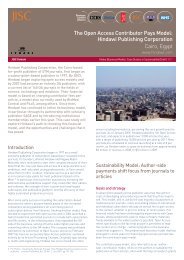A Concise Guide to Researching Audiences - Strategic Content ...
A Concise Guide to Researching Audiences - Strategic Content ...
A Concise Guide to Researching Audiences - Strategic Content ...
You also want an ePaper? Increase the reach of your titles
YUMPU automatically turns print PDFs into web optimized ePapers that Google loves.
The <strong>Guide</strong> <strong>to</strong> <strong>Researching</strong> <strong>Audiences</strong><strong>Concise</strong> editionTable 3‐1: selecting appropriate methods (Key: - unlikely <strong>to</strong> be suitable; * may be suitable, but oflimited use; ** often suitable)Aspect ofaudienceQuantitativesurveyWeb statisticsEthnographicstudiesFocus groupsIndividualinterviewInformalOtherapproachesSize ** ** - - - - -Composition ** * - - - * -Motivations ** * - ** ** * -Attitudes ** * - ** ** - -Satisfaction ** * - ** ** - -Prevalence of non-usage ** - - * - -Reasons for non-usage - - - ** ** - -Patterns of usage - ** ** * * - -Tasks service is used for ** ** ** usertracking** ** - -Lifestyle * - ** * ** - -Service usability * * ** * * - Heuristicevaluation 6User requirements - - ** ** ** * -3.4 <strong>Researching</strong> non-usage 63.4.1 Understanding non-use of a service is important: publicly funded services may have a responsibility <strong>to</strong>service a particular audience (eg senior citizens, ethnic minority communities).3.4.2 Engaging with non-users may be difficult, time-consuming and potentially expensive, but it should beviewed as a necessary part of audience development work. Building relationships with non-users will paydividends: 7• The views of non-users are not represented in user surveys and the digital service is not meeting theirneeds; this may be an important failing• Non-users can provide valuable insights for service development• Engaging non-users can help demonstrate a commitment <strong>to</strong> that audience segment and increaseknowledge about marketing and communication strategies that will be effective for that segment3.4.3 Sub-section 3.5 of the full-version of the <strong>Guide</strong> provides more information on the importance of, difficultieswith, and possible strategies for researching non-users.3.5 Recruiting subjects for audience research3.5.1 Recruiting subjects is a perennial problem and the easiest technique may not always be the best, and maylead <strong>to</strong> an unrepresentative, biased sample. Incentives can be used <strong>to</strong> aid recruitment, but care needs <strong>to</strong> betaken <strong>to</strong> ensure that the incentive is appropriate <strong>to</strong> the audience you seek <strong>to</strong> recruit.6 Heuristic evaluation is where expert evalua<strong>to</strong>rs assess the service’s user interface against recognised usability criteria. This method fallsoutside the scope of this guide but is described briefly in the full-version of the <strong>Guide</strong> because of its utility in the early stages of servicedevelopment.7 Responses <strong>to</strong> a survey may not provide very much information. Engaging more deeply with non-users through focus groups, discussion foraand interviewing will be necessary <strong>to</strong> build a richer, more meaningful understanding of non-usage.PAGE 163. Planning audience research



